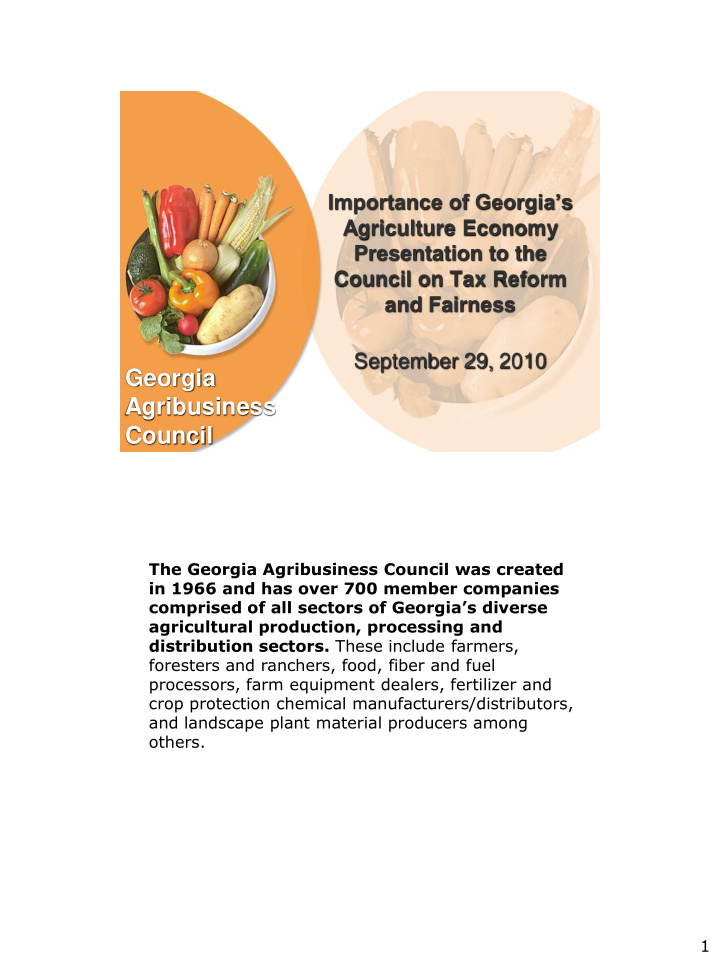



Importance of Georgia’s Agriculture Economy Presentation to the Council on Tax Reform and Fairness September 29, 2010 Georgia Agribusiness Council The Georgia Agribusiness Council was created in 1966 and has over 700 member companies comprised of all sectors of Georgia’s diverse agricultural production, processing and distribution sectors. These include farmers, foresters and ranchers, food, fiber and fuel processors, farm equipment dealers, fertilizer and crop protection chemical manufacturers/distributors, and landscape plant material producers among others. 1
Agribusiness in Georgia Georgia Egg Association Southern Equipment Georgia Milk Dealers Association Producers Association Agriculture was Georgia’s first industry and continues to be the largest economic engine in the state. Agribusiness diversity is a great strength to Georgia’s economy. The organizational logos displayed on this page are but a handful of business interests focused on the agricultural economy and sustainability. Sustainable agriculture is profitable agriculture. 2
* Data from Dr. John McKissick – UGA Center for Agribusiness and Economic Development The 2008 farm gate value was $11.9 billion and this economic impact grows nearly 600 percent when the economic value of inputs and processing are applied . Poultry continues to dominate our production percentages, but the diversity shouldering the economic load has been a great advantage for Georgia. UGA agricultural research and Extension are a strong partner in this success. 3
Broilers Farm Gate Value Forestry 1992 24.0% 17.9% Top Ten Commodities Comparisons: Rest of 1992-2008 Commo- dities 21.8% Peanuts 8.8% Broilers Vegetables 41.0% Misc. 5.4% Beef Poultry Dairy Pork Corn Cotton 4.6% 3.0% 2008 3.7% 3.3% 3.1% 4.4% Rest of commodities Eggs 27.0% 5.0% Cotton 4.9% Farm Gate Value Peanuts Corn 4.9% 1992 = $6.4 billion 2.0% Timber Horses Beef 4.0% Dairy Greenhouse 2008 = $11.9 billion 3.5% 3.1% 2.6% 2.2% * Data from Dr. John McKissick – UGA Center for Agribusiness and Economic Development As we compare agricultural production to 2008 to that of 1992, we can see that the balance of agricultural production remains diverse, but the importance of the poultry industry stands tall. 4
2008 Total Farm Gate Value GA = $11.9 billion $3,500,000 - $20,000,000 $20,000,000 - $45,000,000 $45,000,000 - $80,000,000 $80,000,000 - $200,000,000 $200,000,000 - $442,184,000 * Data from Dr. John McKissick – UGA Center for Agribusiness and Economic Development Food and fiber production (farm gate) are key components of Georgia’s economy. This map showcases the dollar value of the counties across the state. The importance to rural Georgia cannot be overstated. 5
Manufacturing Comparison * Data from Dr. John McKissick – UGA Center for Agribusiness and Economic Development Farm gate production is significant, but the manufacturing of those goods when they leave the farm is also a very important economic factor. 2008 total manufacturing in the state totaled $182.5 billion. This 2008 chart shows that 45% of manufacturing is attributed to agricultural sectors. These include the processing of food and drinks, fabric and leather, wood and paper and the production of inputs and textiles. Examples include, poultry, milk products, peanuts, ginning of cotton, oilseed crushing and more. 6
Direct and indirect economic impact of $65 billion for the state and created more than 351,000 jobs in 2008. In two thirds of Georgia’s counties, food and fiber production and directly related businesses represent the largest or second largest segment of all goods and services produced. * Data from Dr. John McKissick – UGA Center for Agribusiness and Economic Development Combining the farm gate production with the processing/manufacturing and the value of inputs needed to produce these products, the total economic impact generated $65 billion in economic impact for the state and created more than 351 thousand jobs in 2008. This is up from $54.5 billion in 2005. Two thirds of Georgia’s counties have agriculture as their largest or second largest segment of goods produced. This $65 billion in economic impact generated over $1.8 billion in state and local taxes according to the University of Georgia. The map highlights the importance of this industry to Georgia’s rural communities. 7
Tax Policy Considerations Economic Development Opportunities Current sales tax exemptions keep most Georgia agribusinesses competitive with neighboring states. Exempting all inputs for “goods producing” sectors is most desirable for sustainability, job creation, and economic development. Georgia’s current tax policy provides opportunity for agribusiness to compete, albeit unbalanced (some fuel, some equipment, etc.) and far short of the provisions made for other “goods producing” businesses. In keeping with the tax council’s first draft principle of enhancing growth, we suggest consideration of exempting all inputs for “goods producing” sectors. Exempting all inputs for goods producing sectors would also meet draft principle four of the tax council, which seeks a simple, understandable and predictable tax structure. 8
Georgia Agribusiness Council Bryan Tolar btolar@ga-agribusiness.org Data provided by Dr. John McKissick; University of Georgia Center for Agribusiness and Economic Development and from these UGA publications: 2009 Ag Snapshots: http://www.caed.uga.edu/publications/pdf/AG%20SNAPSHOTS%200 9.pdf 2007 County Output and Economic Importance of the Georgia Food and Fiber Industry http://www.caed.uga.edu/publications/2007/pdf/CR-07-05.pdf 9
Recommend
More recommend